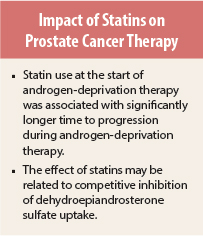Statin use has been associated with improved outcomes in prostate cancer. In a study reported in JAMA Oncology, Lauren C. Harshman, MD, of Dana-Farber Cancer Institute, Boston, and colleagues found that statin use at the time of the initiation of androgen-deprivation therapy was associated with prolonged time to prostate-specific antigen (PSA) progression during androgen-deprivation therapy in men with hormone-sensitive prostate cancer.1 The mechanism of this effect may be the statin’s competitive inhibition of dehydroepiandrosterone sulfate uptake.
Potential Mechanism
DHEAS is a precursor of testosterone that stimulates prostate cancer cell proliferation and a substrate for the organic anionic transporter SLCO2B1, which is also used by statins to enter cells. In studies in vitro in the 22RV1 (which has a relatively high level of SLCO2B1 expression) and LNCaP (which has a relatively low level of SLCO2B1 expression) prostate cancer cell lines, Xiaodong Wang, PhD, of the Kantoff Laboratory, found that statins blocked dehydroepiandrosterone sulfate uptake by competitively binding to SLCO2B1. The degree of uptake inhibition differed among statins within and between cell lines.
In cell proliferation studies, dehydroepiandrosterone sulfate significantly increased proliferation of LNCaP and 22RV1 cell lines that were maintained in androgen-depleted medium. Dehydroepiandrosterone sulfate-induced proliferation was inhibited by statin treatment and prevented by SLCO2B1 knockdown, with statin treatment producing no significant inhibition of SLCO2B1 knocked-down cell proliferation. The findings indicate that statin treatment can inhibit SLCO2B1-mediated dehydroepiandrosterone sulfate uptake and dehydroepiandrosterone sulfate–induced cell growth in androgen-dependent prostate cancer cell lines.
Study Details
The retrospective analysis included 926 patients who had received androgen-deprivation therapy for biochemical or metastatic recurrence or new metastatic disease between January 1996 and November 2013 at Dana-Farber Cancer Institute. Of them, 283 (31%) were taking statins at the start of androgen-deprivation therapy (“statin users”). Progression was defined as at least two increases in PSA level, with the date of progression defined as the date of first increase in PSA level (nadir plus ≥ 0.02 ng/mL).
In total, 93% of statin users continued statin use at the time of progression or at last follow-up. Among the 643 nonusers at the time of initiation of androgen-deprivation therapy, 72 started statin therapy while receiving androgen-deprivation therapy, with a median time of 24 months from androgen-deprivation therapy start to statin use.
Statin users had a lower median PSA level at diagnosis (9.1 vs 11.8 ng/mL) and at androgen-deprivation therapy initiation (10.3 vs 12.5 ng/mL) and a longer median duration from diagnosis to androgen-deprivation therapy initiation (3.85 vs 2.33 years). Moreover, statin users were more likely to have lower-stage disease (56% vs 44% T1 disease, P = .005), less likely to have de novo metastases (11% vs 18%, P = .01) or nodal involvement (5% vs 10%, P = .03) at diagnosis, more likely to have undergone local therapy (82% vs 68%, P < .001) or to have received androgen-deprivation therapy as part of local therapy (33% vs 26%, P = .02), and less likely to have metastases at androgen-deprivation therapy initiation (53% vs 63%, P = .005).
Prolonged Time to Progression
After a median follow-up of 5.8 years, 644 patients (70%) had disease progression while receiving androgen-deprivation therapy, with median time to progression during androgen-deprivation therapy being 20.3 months. Median time to progression was 27.5 months (95% confidence interval [CI] = 21.1–37.7 months) in statin users vs 17.4 months (95% CI = 14.9–21.1 months) in nonusers (P < .001).
After adjusting for predefined prognostic factors including biopsy Gleason score, type of primary therapy, use of prior androgen-deprivation therapy along with localized therapy, metastatic status, and PSA level at initiation of androgen-deprivation therapy, statin use remained a significant predictor of reduced risk of progression (adjusted hazard ratio [HR] = 0.83, P = .04). The results were similar in analysis stratified by year of androgen-deprivation therapy initiation using 5-year increments (adjusted HR = 0.83, 95% CI = 0.69–0.99) and when the 72 patients who started using a statin during androgen-deprivation therapy were excluded from the nonuser group (adjusted HR = 0.71, 95% CI = 0.59–0.85).
A benefit of statin use was observed irrespective of whether patients had radiographic evidence of metastatic disease compared with biochemical relapse only at androgen-deprivation therapy initiation, with adjusted hazard ratios of 0.79 (95% CI = 0.58–1.07) for M0 disease and 0.84 (95% CI = 0.67–1.06) for M1 disease (P = .72 for interaction).
The investigators concluded:
Statin use at the time of androgen-deprivation therapy initiation was associated with a significantly longer time to progression during androgen-deprivation therapy even after adjustment for known prognostic factors. Our in vitro finding that statins competitively reduce dehydroepiandrosterone sulfate uptake, thus effectively decreasing the available intratumoral androgen pool, affords a plausible mechanism to support the clinical observation of prolonged time to progression in statin users. ■
Disclosure: The study was supported by the Dana-Farber Prostate Cancer SPORE and Department of Defense. Dr. Harshman’s research is also supported by a Prostate Cancer Research Foundation Young Investigator Award. For full disclosures of the study authors, visit oncology.jamanetwork.com.
Reference
1. Harshman LC, Wang X, Nakabayashi M, et al: Statin use at the time of initiation of androgen deprivation therapy and time to progression in patients with hormone-sensitive prostate cancer. JAMA Oncol. May 7, 2015 (early release online).



